Circular dichroism

Okay kiddo, have you ever looked at a rainbow and noticed that the colors are always in the same order? This is because the light from the sun is made up of different colors that travel at different speeds.
Now, imagine molecules like your favorite toys. Just like your toys, molecules can be left-handed or right-handed. Some molecules are made up of smaller parts that are mirror images of each other, like two hands that are mirror images of each other.
Circular dichroism is like looking at these molecules to see if they are left or right-handed. Scientists use a special light that travels in a spiral pattern, like a slinky toy, to shine on the molecules. This special light is made up of both left and right-handed light waves, and when it shines on a molecule that is left-handed, it will be absorbed differently than a molecule that is right-handed.
This difference in how the light is absorbed is called circular dichroism. Scientists measure how the light is absorbed to figure out if the molecule is left-handed or right-handed. This is important because sometimes molecules that are left-handed will react differently than molecules that are right-handed, just like how you might use your left hand to pick up a toy car in a different way than you use your right hand.
So, just like how the rainbow always has the same order of colors, circular dichroism lets scientists tell the difference between left-handed and right-handed molecules by measuring how they react to special light.
Now, imagine molecules like your favorite toys. Just like your toys, molecules can be left-handed or right-handed. Some molecules are made up of smaller parts that are mirror images of each other, like two hands that are mirror images of each other.
Circular dichroism is like looking at these molecules to see if they are left or right-handed. Scientists use a special light that travels in a spiral pattern, like a slinky toy, to shine on the molecules. This special light is made up of both left and right-handed light waves, and when it shines on a molecule that is left-handed, it will be absorbed differently than a molecule that is right-handed.
This difference in how the light is absorbed is called circular dichroism. Scientists measure how the light is absorbed to figure out if the molecule is left-handed or right-handed. This is important because sometimes molecules that are left-handed will react differently than molecules that are right-handed, just like how you might use your left hand to pick up a toy car in a different way than you use your right hand.
So, just like how the rainbow always has the same order of colors, circular dichroism lets scientists tell the difference between left-handed and right-handed molecules by measuring how they react to special light.
Related topics others have asked about:
